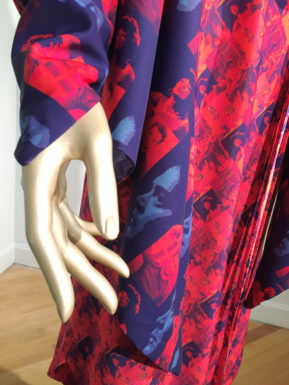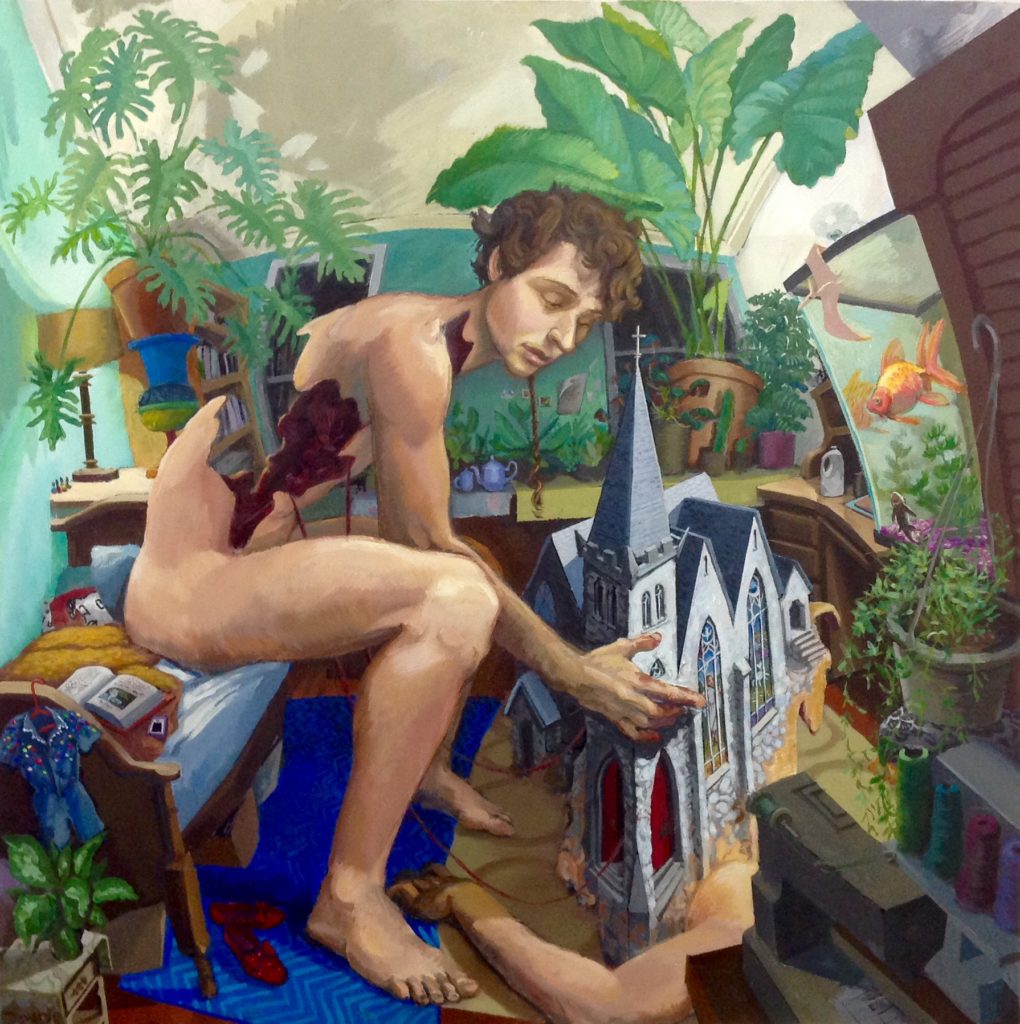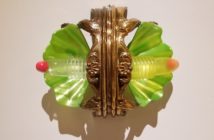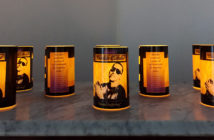Marca X is a cross-institutional endeavor created by the Villa Victoria Center for the Arts, Inquilinos Boricuas en Acción (IBA), the Boston LGBTQIA Artist Alliance (BLAA), the Harvard Ed Portal, and the David Rockefeller Center for Latin American Studies at Harvard. This collaboration presents art that is focused on listening, seeing, and empathizing. I say “empathizing” because the artists gathered at the Villa Victoria Center for the Arts and Harvard Ed Portal Crossings Gallery do not want or need sympathy. Instead, they ask that the audience acknowledge their vulnerability, their agency, and their power.
Out of a juried group of submissions, the organizations’ representatives selected ten artists’ stories to exhibit. They work in performance, sculpture, painting, video, and fashionable textile arts, exploring everything from religious upbringing to capitalism-based cultural immersion. Vulnerability, borne of phobias and systemic mistreatment, is upended and turned into strength, efficacy, and compassion.

Titties, by Rixy Fz. Photo courtesy of Brian Christopher Glaser
Rixy Fz’s sculpture, Titties, is among the first to herald the exhibit’s multi-faceted and intersectional nature. It appears to be a group of gourds rendered in textiles, but only for a moment. Stringy white masses and sequined tassels adorn the breasts, which hang like over-ripened fruit. The strands of lactation spill into a white, viscous puddle on the floor below while the sequins gleam above. Their revelry is unabashed and powerful, and their shapes actively renounce regularity and normativity. They are at once overtly sexual and maternal, adorned and bare.
Polarities manifest frequently throughout the exhibit to highlight stretches of tension and triumph. Jay Calderin’s Redondo Mi R’s (Rolling My R’s) tells of vulnerability reshaped into power and agency. A flamboyantly patterned dress stands in the second half of the exhibition space, regal and impossible to ignore in fiery fuchsia, pink, and purple. It is comprised of two garments—a gown and cape—with a small train flowing behind it. Upon closer inspection, the patterns feature photos and portraits of Rita Moreno, Ricky Martin, and Raul Julia, performing idols Calderin admired in his youth and today.
Calderin, who began sewing and designing garments in his teens, recalls the painful process of coming out, and the self-censoring that accompanied his immediate community’s homophobia. In his statement, the cape is meant to resemble a cocoon and then wings, symbolizing growth and change; however, on the other side of growth and change is adversity. “Mariposa,” I have learned, is a long-standing term of derision against gay men in some Latinx communities. Even when Calderin first ventured into design, he was careful to keep the designs more conservative, less colorful. Today, despite the fear and doubt that haunted his younger years, the dress stands with unswaying verve and irrefutable confidence. It wears its colors proudly and without compromise.

Detail of Jay Calderin's Redondo Mi R's (Rolling My R's)

Redondo Mi R’s (Rolling My R’s) by Jay Calderin. Photo courtesy of Julia Csekö.
However, compromise cannot be parsed in the coming-out process. A painting by Nathan Devarie titled Separation of Church and Nate depicts a moment of solemn and perhaps destructive introspection regarding faith and identity politics. While some can leave their abuses behind, others find the threads of faith impossible to sever.
A looming figure in the artist’s bedroom contemplates a highly detailed cathedral, with Christ depicted lovingly in the miniature stained glass. Strewn amongst the stony base of the structure is the figure’s disembodied arm and languid red strands that trail back to the lone figure, whose back is opened like a shucked oyster. Surprisingly, the figure does not scream in pain. Strewn about the space are nods to the figure’s identity: a sewing machine with spools of vibrant thread, a pair of ruby red slippers and a bedazzled romper. Instead of overt rejection, the figure grasps the cathedral, as if it were a dear heirloom; it is as if the figure seeks to rebuild a bridge that others would keep only as a bittersweet reminder of their liberation.

The Separation between Church and Nate, Nathan Devarie. Photo courtesy of the artist.
It takes a patient and dedicated audience to complete the works and to fully consider the artists’ immense outpouring of emotion. Listening, consideration, and integration are the follow-ups that truly begin the mending process and ignite change. These artists, each following their own path, have found communities to support and foster them. Visibility, while vital, is only a segment of the inchoate process of emotional and social progress. In telling these stories, the artists put a lot of faith in the audience to work with them through their narratives of pain, celebration, empowerment, and vulnerability. None can exist without the other, for the ebb flow of both lack and abundance defines LGBTQIA narratives. While more textured than other personal landscapes, the resilience of all the artists is proudly on display, underscored by their humanity and their frankness.
Marca X will be on view at the Villa Victoria Center for the Arts and the Harvard Ed Portal through February 15th. The gallery can be accessed by appointment by calling coordinator Julia Csekö at 617-927-1717. Additionally, visitors are welcome to join in a conversation with some of the artists on February 8th at 85 West Newton St., Boston.




